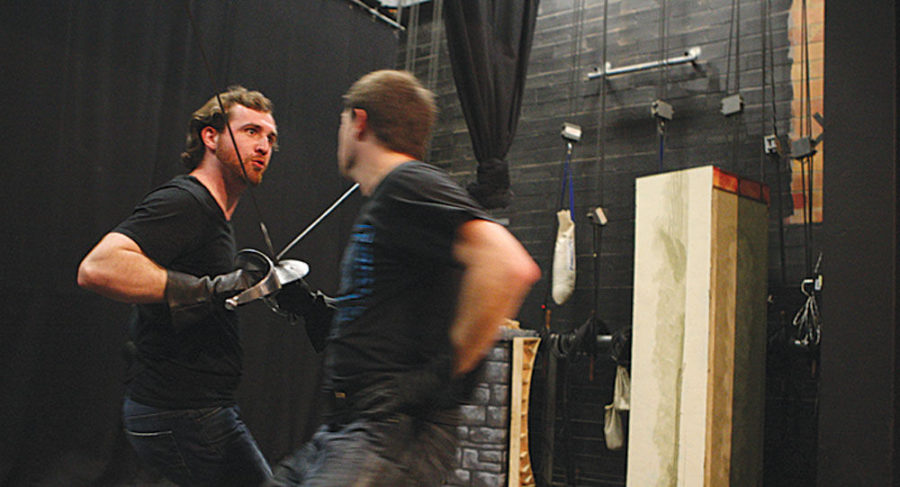Class teaches art of stage fighting
Theater graduates David Theaker (left) and David Alan Clark duel onstage with swords during Andrew Ray’s stage combat class at the Briggs Theater on Wednesday, February 25, 2015 in Lexington, Ky. Photo by Adam Pennavaria
February 26, 2015
By Anne Halliwell
On the Briggs Theatre stage, two young women menaced each other with bared knives for a long heartbeat.
In the space of about three minutes, the two slapped and tore at each other’s hair, punched, parried and stabbed at vulnerable wrists, hips and torsos.
In the end, the first to attack lie dead on a paisley-printed sofa.
Stage fighting instructor Andrew Ray took the stage moments later to discuss the logistics of wearing a skirt in a scramble and the proper amount of humor with which to infuse a death scene.
“If you attack the target, the audience follows the story,” Ray said.
The story, in this case, is that the two actors are genuinely trying to kill one another. It requires timing, accuracy and trust to pull off.
“If you do this,” Ray demonstrated, stabbing far to the left of one participant’s arm, “and then she moves (further away), we see that you were never going to hit her. That graze is good luck — the reaction is that she moves back.”
Taylor Cavins, a theatre junior, and Sloan Gilbert, a theatre sophomore, explained that their scene from “Zastrozzi” shows one character, a criminal seductress, attacking a virginal aristocrat for the love of the same man.
“All of our scenes are from plays that involve violence,” Cavins said. “It’s supposed to showcase that we can handle ourselves, handle the weapons (onstage).”
On Saturday, the class will perform the scenes for a proctor from the Society of American Fight Directors, which has developed a set of criteria to test the “required stage combat techniques for safety, theatrical commitment and believability within a dramatic context,” according to the SAFD website.
Ray said the immediate benefits of stage training were simple — it makes actors more hirable by providing them with a relatively rare skill set, and makes them more aware of their movement onstage.
“Most (beginning actors) aren’t used to connecting with another person onstage or even touching (them),” Ray said. “It’s what we have to do as actors — we have to look violent, or even loving, with someone we met just a few hours ago.”
More important than movement, Ray said, is learning to trust other actors to act safely.
“There’s a lot of plays that end in violence, and some actors who aren’t trained can be violent toward other actors,” Ray said.
There’s an intrinsic trust that needs to be in place, Ray said, for actors to be able to work together in a safe, creative environment.
“You can’t focus on a character and have the acting be there if you’re getting beat up,” he added.
Ray, who graduated with a theatre degree from UK in 2003, is now a certified stage combat instructor with the SAFD.
He teaches any one of the SAFD’s eight stage combat weapons — rapier and dagger, single sword, broadsword, broadsword and shield, smallsword, knife, quarterstaff, and unarmed — during six-week courses every semester.
Ray began in fall 2012, and his course is the only constant university program that can offer certification in all eight weapons to any student, he said.
The “passionate, dedicated” students in Ray’s class pay out-of-pocket and the registration is mainly handled by word-of-mouth among the students, he said.
Almost all of them return in subsequent semesters to pick up new weapon skills.
“We have had, now, three people graduate with all eight (weapons) and three others with at least six,” Ray said. “The ones who really want to focus on this get all eight.”
In the end, though, Ray said some days he feels like a younger version of himself, the “kid with a wooden sword” rescuing people and going on adventures.
“I’m still that kid,” Ray said. “Just with a lot of degrees, and I get to play.”
































































































































































